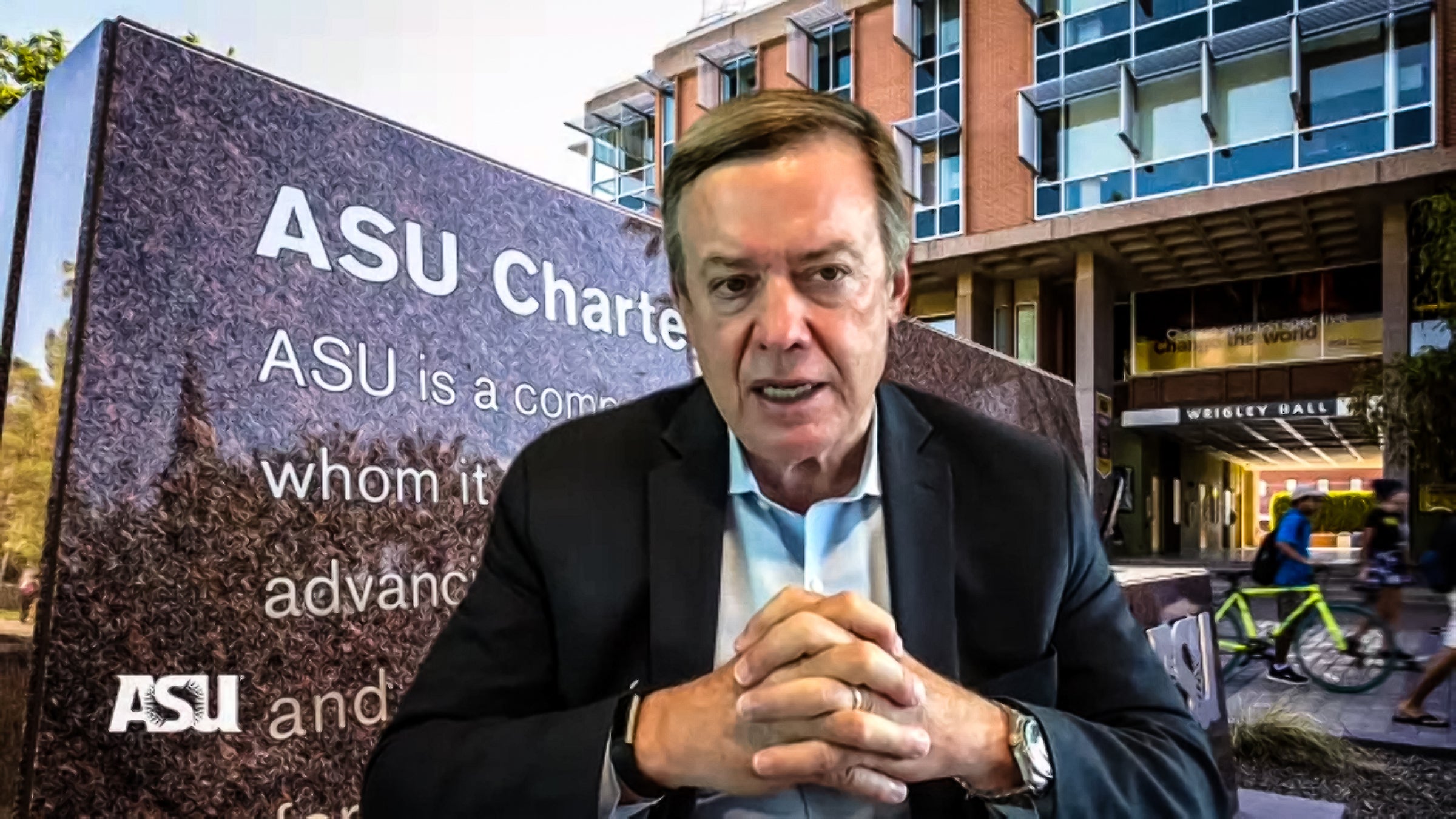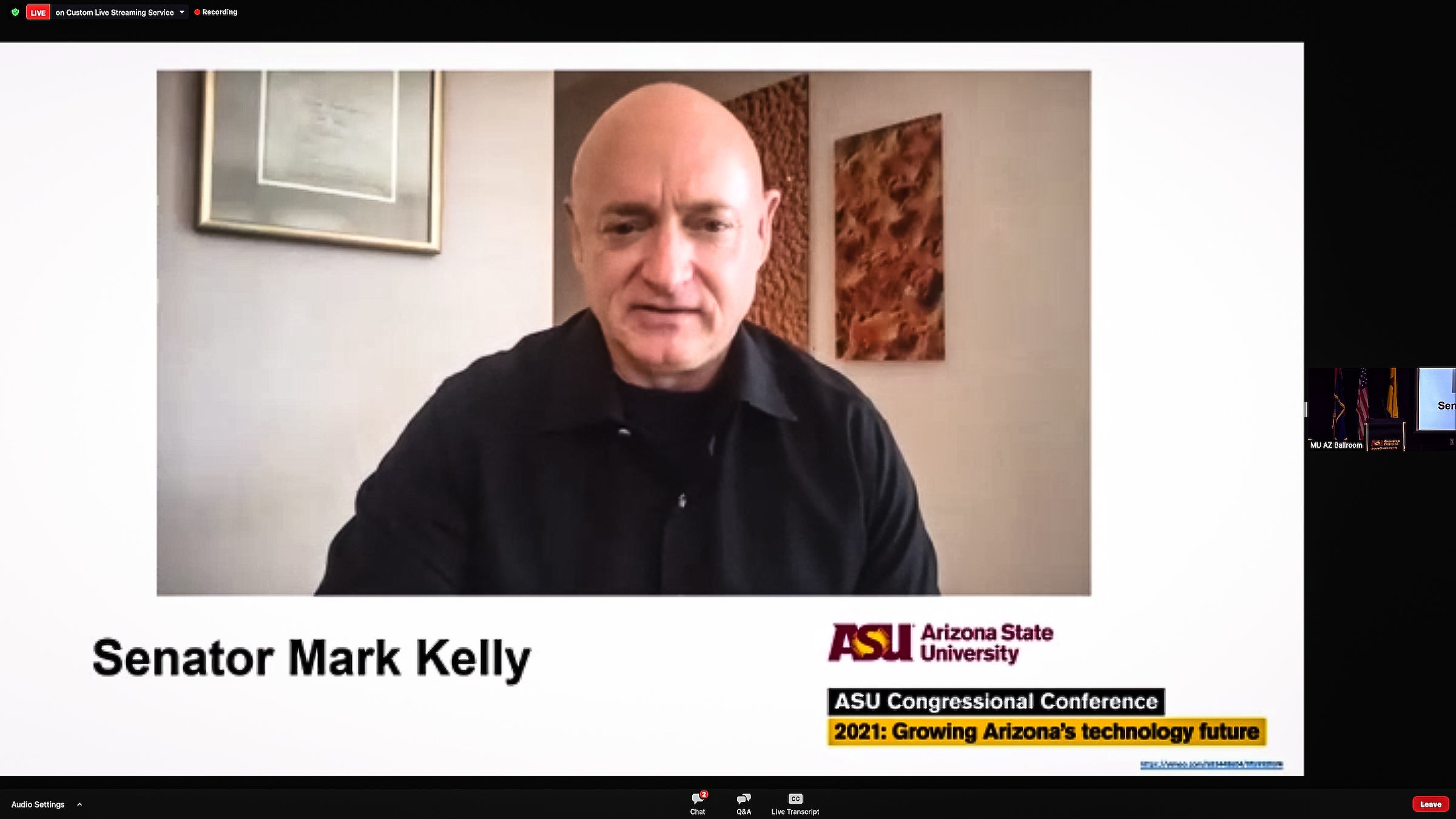Climate, cotton, cattle, citrus and copper.
Arizona’s five Cs have historically been the backbone of the state’s economy.
That’s not going to cut it in the 21st century. For the Grand Canyon State to truly thrive, it will need to become the center of advanced microelectronics.
That was the theme of discussion at the annual Congressional Conference on Aug. 20 at Arizona State University, themed “Growing Arizona’s Technology Future.” The event featured panels and attendees that included members of Congress, mayors and industry experts.
University President Michael Crow opened the daylong event with a call to arms.
“The economy of the future is going to be more computationally driven at every level than anyone can even imagine,” Crow said. “Everything is going to be moving into a hyper computational mode: autonomous vehicles, every system that you can imagine, not 12 billion transistors on the chip that's in your iPhone but 50 billion transistors.”
President Michael Crow welcomes viewers to the ASU Congressional Conference webcast on Aug. 20. Screenshot by Charlie Leight/ASU
What is being called the New Economy Initiative — where engineering is the backbone of Arizona’s success — dovetails with other desirable outcomes, Crow said.
“It turns out that the future of many of the things that we'd like to achieve in in advanced manufacturing and advanced economies, in high-value outcomes, in systems that improve our energy outcomes, are environmental outcomes, are water outcomes — personal safety, our health, our well-being,” he said. “Advanced microelectronics offer us tools and opportunities to advance on every front in every possible way.”
ASU is leading the way by producing engineers. In 2009, ASU had 6,000 engineering students in the Ira A. Fulton Schools of Engineering. This semester there are 25,000 engineering students, making the Fulton Schools the largest engineering school in the country.
The School of Manufacturing Systems and Networks is designed to address next-generation engineering challenges.
“The following is a small thing, but we think we can get it done,” Crow said. “Build the world's greatest scaled engineering school ever constructed (with) research as intense as any engineering school that's ever existed, and larger and more diverse and more capable and more agile than any engineering school that's ever been built.”
International competition is fierce. Microelectronics are in everything, but the U.S. represents only 12% of global microchip manufacturing, Arizona Sen. Mark Kelly said at the conference. There is also a lack of domestic testing facilities.
“We need to develop these lab-to-fab capabilities right here,” Kelly said. “And I believe one of the best places to locate these capabilities is at Arizona State University.”
Arizona Sen. Mark Kelly speaks, via recorded video, at the 2021 ASU Congressional Conference. Screenshot by Charlie Leight/ASU
China has a long-term policy on this, said Eric Hennenhoefer, co-founder and CEO of Cerfe Labs.
“They just invested $150 million in memory, and they have a whole quarter and they plan to hire thousands of people in Shanghai to do it,” Hennenhoefer said. “The part of the message, which is really more to the government, is that if you really want to move this industry back (to the U.S.), you need to make sure you subsidize the whole ecosystem.”
There are more than 150 microprocessors in a car, he pointed out. With the global supply chain so complicated, without one part, you can’t make the car.
There is no monopoly on smart people and brains, said Raja Suresh, director of research at General Dynamics.
“There are smart people all over the world,” Suresh said. “The only way to stay ahead is to constantly keep inventing and leave the competition in the dust. That's the only way to succeed.”
Sally C. Morton, the head of ASU’s Knowledge Enterprise, an organization with annual research expenditures of $640 million, said a lot is in place for success to happen.
“We can train the workforce needed to lead the U.S. in microelectronics manufacturing, and we have the strong industrial base to put the chips into the products that need them,” Morton said. “Now, Arizona must become the focal point for innovation, research and development of the next generation of microelectronics.”
Arizona has more potential than any other state to become the model for what a successful economic democracy is all about, Crow said.
“I think that in Arizona, we have the early seeds all in place right now to become, not the American center for advanced microelectronics design, development and manufacturing and systems integration, but the global center,” he said.
Top image: Sally C. Morton, the executive vice president of Knowledge Enterprise, was the emcee at the ASU Congressional Conference webcast on Aug. 20. The conference theme was “Growing Arizona’s Technology Future.” The event featured several speakers and four panel discussions all with the general focus on turning the state into the global development and manufacturing center for microelectronic systems. Screenshot by Charlie Leight/ASU
More Science and technology

ASU professor wins NIH Director’s New Innovator Award for research linking gene function to brain structure
Life experiences alter us in many ways, including how we act and our mental and physical health. What we go through can even change how our genes work, how the instructions coded into our DNA are…

ASU postdoctoral researcher leads initiative to support graduate student mental health
Olivia Davis had firsthand experience with anxiety and OCD before she entered grad school. Then, during the pandemic and as a result of the growing pressures of the graduate school environment, she…

ASU graduate student researching interplay between family dynamics, ADHD
The symptoms of attention deficit hyperactivity disorder (ADHD) — which include daydreaming, making careless mistakes or taking risks, having a hard time resisting temptation, difficulty getting…


